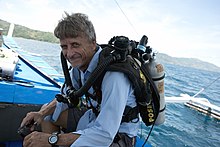| Richard Pyle | |
|---|---|
 Pyle in the Philippines Pyle in the Philippines | |
| Born | 24 March 1967 (1967-03-24) (age 57) Kailua, Hawaii |
| Education | Ph.D., Zoology |
| Alma mater | University of Hawaii at Manoa, Honolulu |
| Scientific career | |
| Fields | Marine biology |
| Institutions | Bishop Museum |
Richard Lawrence Pyle (born 24 March 1967) is a scuba diver and ichthyologist working on Hawaii.
Pyle discovered the principle of "Pyle stops" when decompressing from many deep dives in search of new species of fish, and has identified hundreds of new species.
He is the author of over 130 publications.
In October 2015, he won second prize, an award of €5,000, in the GBIF Ebbe Nielsen Challenge, a Global Biodiversity Information Facility competition, for BioGUID.org, "a web service that crosslinks identifiers linked to data objects in the biodiversity realm". At that time, the site contained over one billion (1,000,000,000) identifiers. He has been honoured by having the twilight fangblenny (Petroscirtes pylei) named in his honor.
Pyle is a member of ZooBank Committee and the leader of ZooBank architecture policy working group.
See also
References
- ^ "Hawaii Biological Survey Staff, Richard L. Pyle". Bishop Museum. 2009. Retrieved 6 April 2016.
- Pyle, Richard. "Curriculum vitae, Richard L Pyle, Department of Natural Sciences, Bishop Museum, Honolulu". Retrieved 30 December 2016.
- Pyle, Richard L. (1997). "The importance of deep safety stops: Rethinking ascent patterns from decompression dives". Journal of the South Pacific Underwater Medicine Society. South Pacific Underwater Medicine Society. Archived from the original on May 25, 2013. Retrieved 9 March 2016.
- "Richard Pyle". TED.com. Retrieved 6 April 2016.
- ^ "Winners named for first GBIF Ebbe Nielsen Challenge". Global Biodiversity Information Facility. 30 October 2015. Retrieved 30 June 2016.
- Christopher Scharpf; Kenneth J. Lazara (26 October 2018). "Order BLENNIIFORMES: Family BLENNIIDAE". The ETYFish Project Fish Name Etymology Database. Christopher Scharpf and Kenneth J. Lazara. Retrieved 7 April 2019.
- "ZooBank Committee", accessed 6 November 2017.
External links
This article about a biologist is a stub. You can help Misplaced Pages by expanding it. |
This diving-related article is a stub. You can help Misplaced Pages by expanding it. |